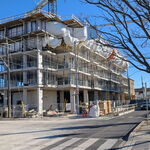Converting to low-floor LRT is a bad idea. But converting to OL-type light metro, or high-floor LRT, should not be too difficult.
My gut is that retaining the same wide-body subway technology is OK if we expect this line to never get extended past STC (or McCowan) in the east, and past Sheppard West (Allen Rd) in the west.
But if we want it to reach Pearson in the west, and perhaps connect to the Lakeshore East RER line at Port Union.
I don't know if it has been discussed yet, but connecting Line 4 to Lakeshore RER is a
brilliant idea. It would essentially turn Line 4 into an extension of the RER network spanning the north of Toronto.
Broadly speaking, westbound Lakeshore RER commuters would transfer at Port Union and then use Line 4 to access any destinations in Toronto roughly north of Eglinton. For example, a commuter from Durham travelling to Lawrence Station would use Line 4.
The ridership potential is high.
In this scenario, it would also make sense to extend Line 4 to
at least Downsview Station, to let those RER commuters access the Spadina Line.
This would dramatically alter travel patterns in Durham Region and northern areas of Toronto. It would suddenly becomes viable for Durham residents to access areas like UTSC, Scarborough Town Centre, North York Center, York University, etc via transit.
This would also function as a "Union Station Relief Line". Metrolinx has been looking for ways to reduce crowding at Union Station, and this Line 4 extension could divert a meaningful amount of passenger crowding away from Union Station.
However, the Ontario Line would obviously have to be extended north to Sheppard prior to extending Line 4, otherwise we'd overcrowd the Yonge Line even further.




